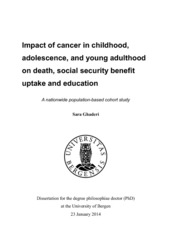Impact of cancer in childhood, adolescence, and young adulthood on death, social security benefit uptake and education. A nationwide population-based cohort study
Doctoral thesis
Permanent lenke
https://hdl.handle.net/1956/7770Utgivelsesdato
2014-01-23Metadata
Vis full innførselSamlinger
Sammendrag
Background: Improved survival for childhood and adolescent cancer patients due to advances in medical and supportive care is a great achievement of modern medicine. As the number of long-term survivors of cancer in childhood and adolescence is growing rapidly, increasing attention is being paid to the possible impact of the disease and its treatment on long-term health and social performance. Impact of cancer in childhood (0– 14 years), adolescence (15–19 years) and young adulthood (20–24 years) on early cancer death, uptake of social security benefits and educational attainment has been explored in a national cohort. Material and methods: All children born alive in Norway during 1965–1985 were identified by the Norwegian Central Population Registry and defined as the study cohort (approximately 1.2 million individuals). By linkage to the Cancer Registry of Norway, all children (N=2,481), adolescents (N=1,289) and young adults (N=2,032) diagnosed with cancer were identified. The cohort was followed from birth into adulthood by further linkage to compulsory national databases; the Cause of Death Registry, the National Insurance Scheme, and the Norwegian National Education Database. These registries include data on mortality, social security benefits, and education which were the main outcomes. Data were analysed by applying various regression models that allow for adjustment for confounders; Cox regression, logistic regression and competing risk model. Standardized incidence ratios were used in cases of rare outcomes. Results: Differences in overall mortality between the cancer patients and the cancer-free population decreased during our study period. Early cancer mortality (within 5-years after diagnosis) for all cancers also decreased since 1965. Overall, there were relatively fewer cancer-related deaths among female than male patients. Adolescents and young adult patients had lower risk of cancer death than children in general, except for patients who were diagnosed with leukaemia (all combined). Overall, 5-year cancer survivors were 4.4 times more likely to receive any kind of social security benefits than the cancer-free population. Survivors from bone and connective/soft tissue tumours, central nervous system (CNS) tumours and leukaemia were most likely to be recipients of social security benefits. After neoplasms, the most common causes of receiving social security benefits were diseases of the nervous system, and injury and poisoning. In general, completion of education was lower among 5-year cancer survivors than the cancer-free population at all levels i.e. intermediate, under graduate and graduate education. Mainly survivors of CNS-tumours and those assumed to have received CNSdirected therapy were at risk of educational deficits and experienced some delays in completion of an educational level. However, educational impairment diminished at higher levels of education, and consequently choice of educational fields was similar for the cancer survivors and the cancer-free population. Conclusions: More cancer patients become 5-year survivors today compared to earlier. These survivors are at increased risk of late effects. Medical surveillance and supportive care is therefore of high importance for the cancer survivors. Special attention should be paid to survivors of CNS-tumours, leukaemia and bone and connective/soft tissues tumours since they were at higher risk for late effects compared with other survivors. Careful follow-up of cancer survivors during their education is also recommended in order to maximize educational achievements.
Består av
Paper 1: Ghaderi S, Lie RT, Moster D, Ruud E, Syse A, Wesenberg F, Bjørge T. Cancer in childhood, adolescence, and young adults: A population-based study of changes in risk of cancer death during four decades in Norway. Cancer Causes Control 2012; 23(8):1297-305. The article is not available in BORA due to publisher restrictions. The published version is available at: http://dx.doi.org/10.1007/s10552-012-0007-xPaper 2: Ghaderi S, Engeland A, Moster D, Ruud E, Syse A, Wesenberg F, Bjørge T. Increased uptake of social security benefits among long-term survivors of cancer in childhood, adolescence and young adulthood: A Norwegian population-based cohort study. Br J Cancer 2013; 108(7):1525-33. The article is not available in BORA due to publisher restrictions. The published version is available at: http://www.nature.com/bjc/journal/v108/n7/full/bjc2013107a.html
Paper 3: Ghaderi S, Engeland A, Gunnes MW, Moster D, Ruud E, Syse A, Wesenberg F, Bjørge T. Educational attainment and choice of educational fields among longterm survivors of cancer in childhood and adolescence: A Norwegian populationbased cohort study. The article is not available in BORA.
